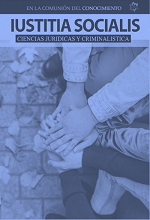Human Rights from the environmental impact of solid waste
DOI:
https://doi.org/10.35381/racji.v5i3.1105Keywords:
Environmental deterioration, collective human rights, nature conservation.Abstract
Garbage is the world's main health and environmental problem. In the Montalvo canton, the final disposal of the garbage is located on the banks of the Cristal river and its slopes, it does not have any type of treatment, causing terrible damage to the nearest community, which is the Ernestina enclosure. The general objective of the investigation is to expose the violation of the rights of the inhabitants of the Ernestina compound since they are being affected by the contamination. The research is with a quantitative paradigmatic vision, of a bibliographic documentary type. Synthetic and analytical methods were used as applied methods. It is concluded that it is necessary to respect the rights established in the Fundamental Charter, allowing the protection of nature and the health of the inhabitants, and to comply with what is stated in the constitutional postulates regarding the rights of all people and the environment. environment.
Downloads
References
Asamblea Nacional de la República del Ecuador. (2014). Código Orgánico Integral Penal. [Comprehensive Organic Criminal Code]. Recuperado de https://n9.cl/g6sc
Asamblea Nacional Constituyente de la República del Ecuador, (2008). Constitución de la República del Ecuador. Montecristi. Registro Oficial 449 de 20-oct-2008. Recuperado de https://n9.cl/sia
Asamblea Nacional de la República del Ecuador. (2015). Codigo Código Orgánico General de Procesos. [Code General Organic Code of Processes] Registro Oficial N° 506.
Asamblea Nacional Constituyente. (2010). Código orgánico de organización territorial Autonomía y descentralización. [Organic code of territorial organization Autonomy and decentralization]. Registro Oficial Suplemento 303 de 19-oct-2010 Recuperado de: https://n9.cl/d9vg
Asamblea Nacional (2010). Código Orgánico de Organización Territorial, Autonomía y Descentralización. [Organic Code of Territorial Organization, Autonomy and Decentralization]. Registro oficial 303 de 19 de oct-2010.
Asamblea Constituyente de la República del Ecuador. (2017). Código Orgánico del Ambiente.
Asamblea Constituyente. (2017). Código Orgánico del Ambiente. [Organic Environment Code]. Quito, Pichincha, Ecuador: Registro Oficial 983.
Cuvi, N. (2015). Ecología política y geográfica crítica de la basura en el Ecuador.[ Critical political and geographical ecology of litter in Ecuador]. Revista Latinoamerica de estudios socioambientales Facso Ecuador, 4-10. Recuperado de https://n9.cl/utluz
García-Bastida, R., Socorro-Castro, A. & Vanessa-Maldonado, A. (2019) Manejo y gestión ambiental de los desechos sólidos, estudio de casos. [Control and environmental management of solid waste, case study]. Universidad y Sociedad.11(1),265-271.
Ministerio del Ambiente (2018). Dirección Nacional de Control Ambiental. https://n9.cl/8xw76
Ministerio del Ambiente (2017). Texto Unificado de Legislación Secundaria de Medio Ambiente. [Unified Text of Secondary Environmental Legislation]. Decreto Ejecutivo 3516 Registro Oficial Edición Especial 2 de 31-mar-2003.
ONU Medio Ambiente. (2018). Cómo la basura afecta al desarrollo de América Latina. [How garbage affects the development of Latin America]. Recuperado de: https://n9.cl/7c3sj
Published
How to Cite
Issue
Section
License
CC BY-NC-SA : Esta licencia permite a los reutilizadores distribuir, remezclar, adaptar y construir sobre el material en cualquier medio o formato solo con fines no comerciales, y solo siempre y cuando se dé la atribución al creador. Si remezcla, adapta o construye sobre el material, debe licenciar el material modificado bajo términos idénticos.
OAI-PMH URL: https://fundacionkoinonia.com.ve/ojs/index.php/Iustitia_Socialis/oai










